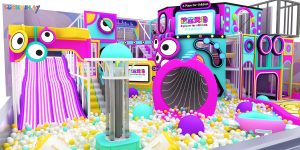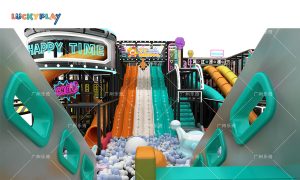Introduction
On a rainy weekend or a scorching summer day, parents often scramble for ideas to keep their children entertained and active. Enter indoor playgrounds that are colorful, exciting, and safe spaces designed to let kids be kids no matter the weather. Among the most popular of these are indoor trampoline parks, where bouncing off the walls is encouraged.
These spaces have become more than just a way to release pent-up energy; they’re places where kids develop physical skills, social confidence, and even emotional well-being. In this article, we explore the world of indoor playgrounds, especially trampoline-based setups, and why they’ve become staples in communities around the globe.
The Rise of Indoor Playgrounds
Over the last decade, indoor playgrounds have seen a massive surge in popularity. Originally small-scale businesses tucked into shopping centers, today’s indoor play centers are sprawling complexes with multi-level jungle gyms, obstacle courses, foam pits, and wall-to-wall trampolines.
This shift has been largely driven by:
- Urbanization (less access to big outdoor spaces)
- Weather unpredictability
- Parental concern for safety
- Demand for physically engaging activities that don’t involve screens
Parents appreciate these facilities not only for their entertainment value but also for their educational and developmental benefits.
Benefits of Trampoline-Based Indoor Playgrounds
Trampoline parks go far beyond just jumping. They offer a full-body workout, improve balance and coordination, and foster teamwork and social interaction.
1. Physical Development
Jumping on a trampoline strengthens muscles, improves cardiovascular health, and enhances motor skills. Even simple bouncing requires coordination between the brain and body, boosting balance and reaction time.
According to pediatric experts, 30 minutes of moderate to vigorous physical activity daily is essential for children’s growth, and trampoline parks are a fun way to meet this goal.
2. Emotional and Mental Health
Kids naturally feel joy when jumping—it releases endorphins, the body’s “happy hormones.” That’s why trampoline parks often leave kids with huge smiles and improved moods.
It also builds confidence. Whether it’s doing a small jump off a foam block or mastering a somersault, overcoming these mini challenges gives children a sense of achievement.
3. Social Engagement
In a digital age where kids are increasingly isolated behind screens, indoor playgrounds provide an opportunity for real-life interaction. Children make new friends, learn to share and take turns, and even resolve minor disputes are all valuable social lessons.
4. Safe Environment for Active Play
One of the main draws for parents is safety. These facilities are built with padded floors, trained staff, and clear safety rules. There’s no need to worry about uneven ground, harsh weather, or unmonitored environments.
Popular Features Found in Indoor Trampoline Playgrounds
Each indoor playground has its own unique spin, but most include a mix of the following attractions:
a. Main Jump Area
A vast open space filled with interconnected trampolines. Kids of all ages can bounce freely here, run, or do tricks under supervision.
b. Foam Pit
A soft-landing area filled with foam cubes. Children can jump from trampolines or elevated platforms into the pit, practicing flips or just enjoying the sensation of falling safely.
c. Dodgeball Zone
A trampoline-based dodgeball court where kids (and even adults) can play competitive but safe games.
d. Climbing Walls and Ropes
Many facilities combine trampolines with climbing features to develop upper body strength and confidence.
e. Toddler Zones
Dedicated areas for younger children with softer play equipment, smaller trampolines, and age-appropriate toys. It allows toddlers to explore without interference from bigger kids.
Safety First: What Parents Should Know
Despite the fun and freedom of movement, indoor trampoline parks maintain strict safety protocols:
- Staff supervision is mandatory in all play zones.
- Grip socks are usually required to prevent slipping.
- Weight and age limits may apply in certain areas.
- Rules like one jumper per trampoline help prevent collisions.
- Facilities are cleaned regularly, especially high-contact surfaces.
Parents are encouraged to check the credentials of the playground, including staff training, first aid readiness, and equipment maintenance.
Hosting Events and Parties
One reason these playgrounds are booming is their popularity as party venues. Many centers offer all-in-one birthday packages with:
- Private play time
- Themed rooms
- Food and drinks
- Event hosts who manage everything
This convenience is a huge plus for parents and unforgettable for kids. Group bookings, school field trips, and even corporate family days are also common.
The Business Side of Indoor Playgrounds
From a business standpoint, indoor playgrounds are a smart venture:
- High demand from families year-round
- Diverse revenue streams (entry fees, parties, snacks, merchandise)
- Opportunities for franchising and brand expansion
That said, running such a facility isn’t cheap. Business owners invest heavily in:
- High-quality, durable materials
- Liability insurance
- Staff training
- Cleanliness and maintenance
But when done right, the payoff is not just profit. It’s a loyal customer base and a meaningful place in the community.
Challenges and Improvements in the Industry
Like all businesses, trampoline parks face some challenges:
- Injury risk: While rare, injuries do occur. Some critics argue that not all parks enforce rules consistently.
- Overcrowding: Busy days can make the space chaotic if not managed properly.
- Maintenance: Trampolines, padding, and foam cubes wear out and need regular replacement.
To improve, many parks now use smart sensors, booking systems, and capacity limits to ensure smoother operations. Some even incorporate virtual reality zones or interactive LED floors to keep older kids engaged.
Indoor Playgrounds and Childhood Development
Beyond the fun and fitness, indoor play helps in child development in critical ways:
– Cognitive Skills
Problem-solving is part of the fun and figuring out how to climb, balance, or jump over obstacles enhances thinking skills.
– Creative Play
Role-playing in themed zones or coming up with imaginary games improves creativity.
– Resilience
Trying and failing at physical tasks teaches persistence and resilience—skills that serve kids throughout life.
Indoor playgrounds become more than places to play; they’re spaces where kids grow in mind, body, and heart.
What to Look for in a Good Indoor Playground
Parents should consider:
- Cleanliness and how often the space is sanitized
- Diversity of activities for various age groups
- Staff interaction – do they guide or just supervise?
- Seating areas for parents
- Food and drink options
- Safety protocols
Visiting during off-peak hours is also helpful for first timers to get a feel for the space.
Conclusion
Indoor playgrounds, especially trampoline parks, offer far more than just a fun day out. They are safe havens for movement, learning, friendship, and joy. In a world filled with digital distractions and confined routines, these colorful bounce-filled spaces are a refreshing reminder that play is powerful.
So next time you’re looking for an exciting, energy-burning, and development-boosting activity for your kids and look no further than your nearest indoor trampoline park. It’s a win for kids and a relief for parents.







